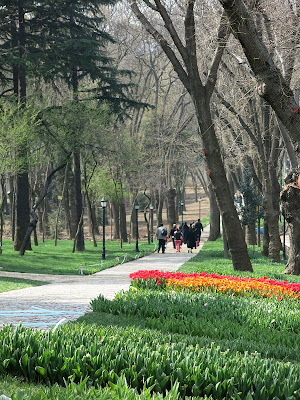Although the tulip is generally associated with Holland, the flower originates in Central Asia and was beloved by the Ottoman sultans. It's thought that the tulip actually came to Holland via Ogier Ghiselin de Busbecq, the Holy Roman Empire's ambassador to Constantinople in the mid-1500s.
For almost the last decade, the Istanbul municipality has embraced this history every year with a tulip festival held the month of April. Last year, the city planted 11.5 million tulips across the city, at a cost of nearly $1.5 million. This year, the municipality is also celebrating with the opening of a tulip museum at Emirgan Park on April 7.
Although the tulip festival doesn't actually start until April 1, there's no holding the flowers back, and there were a number of tulips in bloom when we were at the park on Sunday. It was also abundantly clear that the park wasn't quite ready for visitors -- there were a number of muddy spots, and gardeners were busily planting (or re-planting?) some sections.
But still, it was lovely, and the park was delightfully serene. There aren't a lot of green spots in Istanbul, and it was just so nice to wander along the paths under the trees.


In addition to the "regular" batches of tulips planted along the pathways, Emirgan Park also has a couple of special flower arrangements. Last year, there were some tulips planted in the shape of tulips, the Turkish flag and the evil eye. This year, the Turkish flag plot had been converted into a map of Turkey while the evil eye became a cintamani.
I also saw a squirrel! Now, I know this doesn't seem like a big thing, but I have never seen a squirrel in Istanbul. It was like sighting a unicorn -- parents stopped to point out this one lone squirrel to their kids, and the little kids were watching it with wide eyes, it was very cute.
There were also bees...


When we were at Emirgan Park last spring, there were a number of brides and grooms there to take their photos among the tulips, and this year, even early in the season, it was the same. [The red wedding dress is unusual, by the way -- I have never seen a non-white wedding dress here before. The veil/hood is a religious style, functioning as a head scarf.]
Some last Emirgan Park tulip photos...
How cool is this Istanbul Trees and Landscape logo? I love the Istanbul landmarks coming out of the tree.
There are a number of places to see the tulips in Istanbul, by the way. In addition to Emirgan Park, there's also Soğanlı Park (by the old city walls near the Panorama 1453 museum), Gulhane Park in Sultanahmet, Yildiz Park in Besiktas, and the Goztepe Rose Garden on the Asian side, among others.
After we left Emirgan Park, we walked along the Bosporus for awhile. The weather wasn't especially warm, but it was more than pleasant in the sun. It was just so great to be out along the water -- a stroll along the Bosporus alone is worth coming to Istanbul for.
































